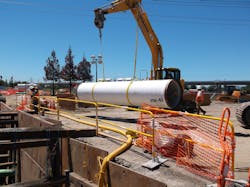Keys to Successful Utility Work
In any large, complex transit project, one of the biggest challenges is minimizing utility relocations and service interruptions. Transit projects frequently pass through utilities, both above and below ground, which exist along project corridors. This affects multiple stakeholders, including public and private utility owners, city, county and regional agencies, as well as the traveling public, residents and businesses. Navigating this tricky challenge requires a carefully planned utility coordination and relocation program.
Such was the case with the Bay Area Rapid Transit (BART) Silicon Valley Extension, the largest public works project currently underway in South Bay history. The first phase of the project — a 10-mile, two station extension called Berryessa Extension — begins south of the future Warm Springs station in Fremont, proceeds through Milpitas and ends in the Berryessa area of north San Jose.
To build this $2.3 billion extension, the Santa Clara Valley Transportation Authority (VTA), which is overseeing the construction, implemented a successful utility coordination and relocation program in collaboration with the design-build team comprising the Skanska, Shimmick and Herzog (SSH) joint venture, Lockwood, Andrews & Newnam Inc. (LAN), a planning, engineering and program management firm, and T.Y. Lin International Group.
There were several factors that paved the way for the success of the utility program. Below are the five most critical factors:
• Preparation: Long before the design and construction of the Berryessa Extension, VTA laid the groundwork for the project. In 2002, VTA purchased from Union Pacific Rail Road (UPRR) a 15-mile, north/south right of way — the planned alignment for the future BART extension to the South Bay. Seven years later, VTA began clearing the way for the transit corridor through a $36 million freight rail relocation project. As part of this project, VTA worked with UPRR to relocate the operating railroad to the western side of the corridor and also relocate longitudinal utilities away from the future BART alignment. This corridor preparation project also included depressing Warren Avenue and Kato Road (major intersections in south Fremont) beneath the railroad tracks and enhancing flood control measures at multiple creek crossings.
• Coordination: The Berryessa Extension corridor runs through three cities (Fremont, Milpitas, and San José) and two counties (Santa Clara and Alameda). There are as many as 13 utilities owners, including Pacific Gas & Electric, Chevron and MCI, in this corridor. VTA and the design-build team reached out to the utility owners early during the project and signed agreements to define each party’s responsibilities during design and construction. A major component of the project involved coordinating with the different utility owners to ensure their relocation designs didn’t conflict with the project team’s design plans. A robust production program was put in place that included an internal permitting process requiring signoffs daily before excavation. In addition, the project team coordinated with numerous public and private agencies that had jurisdiction over the project. These included the three cities and two counties, BART, the Federal Transit Administration, the U.S. Army Corps of Engineers, Caltrans California Public Utilities Commission, the Santa Clara Valley Water District, Alameda County Water District and the Regional Water Quality Control Board, among others.
• Investigation: A complex network of storm drains, sanitary sewers, water mains, petroleum and nitrogen lines, electricity and gas lines, and communication lines cross the Berryessa Extension corridor both horizontally and vertically. To determine the exact locations and dimensions of these utilities, the project team conducted an intensive utility investigation. Data collected through standard techniques such as existing records research, survey of visible utility appurtenances, utility location services, and test holes were entered into a utility matrix. Additionally, the project team generated a 3D geometric model using the horizontal and vertical data for every utility. The combination of the utility matrix and 3D modeling enabled the team to gain a better understanding of the project and figure out solutions to potential utility conflicts.
• Innovation: In some situations, unique engineering solutions were implemented to avoid utility relocations. For example, at the Sierra/Lundy intersection in San Jose, initial design plans called for a shallow guideway trench that disrupted numerous utility lines and required the construction of huge siphons for storm water and wastewater. The design team developed an alternative whereby the track alignment would be lowered deeper at the intersection in cut-and-cover tunnel. This solution dramatically reduced disruption of the intersection during construction and eliminated the need for numerous utility relocations and also eliminated the need for the siphons, saving significant time and money for the project. In another instance, the team did a lift and lay for a major fiberoptic cable with hundreds of fiber pairs, preventing its relocation that would have taken another six months.
• Public Education: Public education has also played a critical role in the project’s success to-date. At every stage of the utility work, the project’s community outreach team provided timely, pertinent information and responded to public inquiries or concerns via VTA’s hotline and e-mail. VTA's website also provided links to the project’s fact sheets, news releases, maps, calendars/schedules, graphics, videos, and other multimedia resources. As activities progressed, updates and information were made available via Facebook and Twitter. In addition to information provided at VTA's website, residents, businesses, commuters, and the general public also received project updates via news stories, newsletters, signage, email updates, and fliers.
Thanks to these proactive steps, VTA and the design-build team have accelerated the project schedule for the Berryessa Extension. The extension will open to the public in late fall 2017, several months ahead of the original schedule. Completion of this initial phase will make the South Bay community’s long-awaited dream of bringing regional transit service into Silicon Valley a reality.
Bernice Alaniz is the director of communications and public affairs at the Santa Clara Valley Transportation Authority (VTA). Timothy J. Schmidt is a senior associate and director — Northern California at Lockwood, Andrews & Newnam Inc. (LAN).
